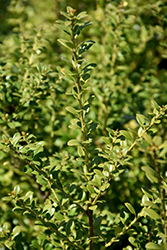It's all about ...
plants

Cherokee Japanese Holly
Ilex crenata 'Cherokee'
Height: 10 feet
Spread: 10 feet
Sunlight:
![]()
![]()
Hardiness Zone: 7a
Other Names: Boxleaf Holly
Description:
A distinctive, upright, selection, particularly superior for massing, hedges and topiary; takes pruning very well; small rounded leaves add aesthetic value; white flowers in spring followed by black berries in fall; a hardy, disease resistant variety
Ornamental Features
Cherokee Japanese Holly is primarily grown for its highly ornamental fruit. The fruits are showy black drupes carried in abundance from early to mid fall. It is bathed in stunning clusters of white flowers along the branches in late spring. It has dark green evergreen foliage which emerges light green in spring. The small glossy oval leaves remain dark green throughout the winter.
Landscape Attributes
Cherokee Japanese Holly is a dense multi-stemmed evergreen shrub with a more or less rounded form. Its relatively fine texture sets it apart from other landscape plants with less refined foliage.
This shrub will require occasional maintenance and upkeep, and is best pruned in late winter once the threat of extreme cold has passed. It is a good choice for attracting birds to your yard. It has no significant negative characteristics.
Cherokee Japanese Holly is recommended for the following landscape applications;
- Accent
- Mass Planting
- Hedges/Screening
- General Garden Use
Planting & Growing
Cherokee Japanese Holly will grow to be about 10 feet tall at maturity, with a spread of 10 feet. It tends to fill out right to the ground and therefore doesn't necessarily require facer plants in front, and is suitable for planting under power lines. It grows at a slow rate, and under ideal conditions can be expected to live for 40 years or more. This is a dioecious species, meaning that individual plants are either male or female. Only the females will produce fruit, and a male variety of the same species is required nearby as a pollinator.
This shrub does best in full sun to partial shade. It prefers to grow in average to moist conditions, and shouldn't be allowed to dry out. This plant should not require much in the way of fertilizing once established, although it may appreciate a shot of general-purpose fertilizer from time to time early in the growing season. It is very fussy about its soil conditions and must have rich, acidic soils to ensure success, and is subject to chlorosis (yellowing) of the foliage in alkaline soils. It is highly tolerant of urban pollution and will even thrive in inner city environments. Consider applying a thick mulch around the root zone in winter to protect it in exposed locations or colder microclimates. This is a selected variety of a species not originally from North America.
This plant is not reliably hardy in our region, and certain restrictions may apply; contact the store for more information.
